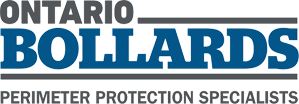K-Rated Bollards vs. M-Rated Bollards
Bollards are a common sight at the front of nearly any commercial building. Typically installed near entrances, these architectural structures protect pedestrians and buildings from damage caused by oncoming vehicles. They are available in numerous variations to suit different purposes, such as preventing cars from inadvertently ending up on the sidewalk, minimizing the risk of vehicles rubbing against buildings in drive-thrus, or stopping heavy-duty vehicles from ramming into high-security facilities. In applications where there is a high risk of vehicle impact, crash-rated bollards are generally installed. These bollards are commonly rated based on one of two crash rating systems: K-ratings or M-ratings.
The following article discusses the differences between these two bollard crash rating systems.
K-Rated Bollards
K-rating bollard standards were originally developed by the United States Department of State (DOS) in 1985 and later revised by the DOS and Department of Defense (DOD) in 2003. Bollards that complied with these standards needed to withstand impact from 15,000-pound payloads (approximately the size of a medium-duty truck) moving at 30, 40, or 50 mph, depending on the rating.
- K4-rated bollards stop 15,000-pound vehicles moving at 30 mph (48 kph).
- K8-rated bollards stop 15,000-pound vehicles moving at 40 mph (65 kph).
- K12-rated bollards stop 15,000-pound vehicles moving at 50 mph (80 kph).
Following 9/11 and an increasing interest in developing technology to guard against criminal/terrorist attacks on buildings, the DOS updated these standards in 2003 to focus on the bollard’s effectiveness at stopping a moving vehicle (given that it is moving within its speed range) from passing the barrier.
- K-rated bollards with L3 certification stop vehicles with less than 3 feet of penetration.
- K-rated bollards with L2 certification stop vehicles with between 3 to 20 feet of penetration.
- K-rated bollards with L1 certification stop vehicles with between 20 to 50 feet of penetration.
Bollards with no certification have an unknown level of penetration resistance.
M-Rated Bollards
Following the widespread installation of K-rated bollards, the American Society of Testing and Materials (ASTM) developed and introduced a more comprehensive bollard crash rating system that focused on a bollard’s ability to stop vehicle penetration through the barrier. This new system largely replaced the older K-rating system as it outlined speed and penetration ratings for a broader range of vehicles, including small passenger vehicles (2,430 lbs.), pickup trucks (5,070 lbs.), medium-duty trucks (15,000 lbs.), and heavy-duty vehicles (65,000 lbs.). However, many industry professionals continue to use the term “K-rating” when talking about barrier crash ratings for medium-duty trucks.
Bollards rated for medium-duty vehicles could receive M-ratings.
- M30-rated bollards stop 15,000-pound vehicles moving at 30 mph (48 kph).
- M40-rated bollards stop 15,000-pound vehicles moving at 40 mph (48 kph).
- M50-rated bollards stop 15,000-pound vehicles moving at 50 mph (48 kph).
They could also be certified regardless of how far a vehicle travels past the barrier.
- M-rated bollards with P1 certification stop vehicles with less than 3.3 feet of penetration.
- M-rated bollards with P2 certification stop vehicles with between 3.31 to 23 feet of penetration.
- M-rated bollards with P3 certification stop vehicles with between 23.1 to 98.4 feet of penetration.
- M-rated bollards with P4 certification stop vehicles with over 98.41 feet of penetration.
The revision of the rating standards and the replacement of old standards led to building designers and security experts putting more trust in the ability of M-rated bollards to resist high-speed, heavyweight impacts.
Partner With Ontario Bollards for Quality Protection Products
M-rated bollards—also commonly referred to as K-rated bollards—serve a critical role in anti-terrorism efforts. P1-certified bollards prevent 15,000 lbs. vehicles at a specific speed from penetrating the barrier beyond 36 inches, which helps minimize and/or eliminate the risk of injury to pedestrians and damage to buildings caused by oncoming cars and trucks. If you need K-rated bollards for your facility, Ontario Bollards has got you covered.
At Ontario Bollards, we specialize in supplying, installing, and servicing the equipment you need to protect people and assets at your facility. One of our core product offerings is anti-terrorism (K-rated) bollards. To learn more about our product and service offerings, contact us or request a quote today.
